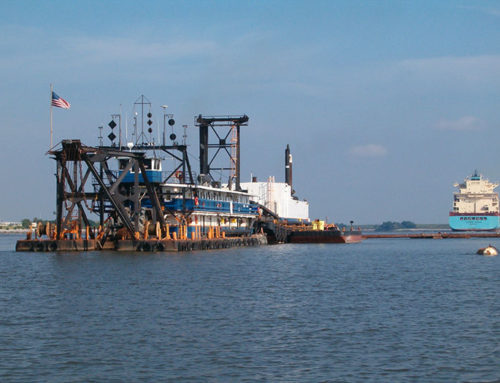At the start of this week, workers from Marinex Construction Inc. began the process of renourishing the beach at Edisto, moving an estimated 956,000 cubic yards from approximately a mile off-shore to the storm-ravaged shore.
At the same time, employees of Crowder Construction Company are at work repairing and extending Edisto Beach’s 26 groins, the fingers that poke into the ocean to try and limit the effects of wave action on the beach. The longer groins will also enable Edisto Beach to have a wider beach, one that will be over 100 feet in depth.
When the work is finished, hopefully by May 1, a reconstituted beach will result. Marinex’s work has to be done by that date, because that is the start of Loggerhead turtle nesting season.
Crowder’s contract allows the company to work past the May 1 deadline, but the town officials are hopeful that the company extending the groins will be finished by May 1. “It all depends upon the weather and how much they can get accomplished,” Edisto Beach Administrator Iris Hill explained.
Hill said Marinex and Crowder began mobilizing at the beach on Jan. 2, bringing in the equipment and material needed to begin their work.
Crowder has already started repairing two of the groins damaged by Hurricane Matthew. Their work began on groin one, located near the Edisto Beach State Park and groin two, located a few hundred feet away.
Thirteen of the groins are being lengthened by installation of composite fiberglass sheet piles; the other 13 will be expanded with grouted armor stone. The work is going to require 9,450 tons of granite armor stone and 345 cubic yards of grout.
Marinex will pull sand from the designated borrow area, a mile off-shore at the south end of the project, and place it on 19,300-linear-feet of shoreline within both the town and Edisto Beach State Park portions of the beach.
In order to meet the May 1 deadline, Marinex will work around the clock bringing the sand to the beach.
Time became a factor after Hurricane Matthew hit the beach in early October.
The renourishment and groin work was already planned. The town had conducted a pre-bid meeting with contractors interested in the two projects and were in the final stages when Hurricane Matthew changed the town’s plans.
In the days following Matthew, Coastal Science and Engineering, the Columbia-based consultant the town had hired to determine the scope of the project and assist with the bid specifications, was back at the beach.
The consultants assessed what Matthew had done to the beach and revised the specifications. The city then scheduled a new pre-bid conference with contactors.
The town officials had been expecting the work to begin in November — Matthew undid that.
Matthew also undid the estimated cost of the project.
Pre-Matthew, the town anticipated a $12 million price tag on the beach renourishment and groin extension projects.
Matthew added another approximately $4 million to the project’s cost estimate.
Edisto Beach officials, working with Colleton County and the state, labored for years to put together the funding to cover the original $12 million price tag.
The additional $4 million needed after Matthew, however, is already in hand. “We are covered thankfully,” Hill said.
The Federal Emergency Management Agency paid Edisto Beach about $1 million, the amount that reflects the town’s expenses from coping with Hurricane Joaquin. State funding from several sources covered the other approximately $3 million.
Marinex was awarded an $11,698,780 contract to handle the beach renourishment; Crowder received a $5,324,000 contact to repair and extend the groins.
Hill said that Hurricane Joaquim had removed an estimated 95,000 cubic yards of sand from the beach when it hit in October of 2015.
When Matthew moved away from the beach early in October 2016, it took an estimated 155,000 cubic yards of sand with it.
Matthew also destroyed all of the dunes in a five-city block-long stretch of beach, dunes that had supplied the beachfront homes some protection from the surges and king tides.
In the days after Matthew hit the beach, the state removed the massive accumulation of sand from Palmetto Boulevard and placed it back on the beach.
Then the town hired an outside contractor to use that sand to install temporary berms to shield the houses that sustained damage from Matthew and could be subjected to further damage from the king tides. “Those berms were pretty much sacrificed to the king tides,” Hill said.
The dunes lost to Matthew will be reinstalled as part of the beach work. The dunes, Hill explained, are Edisto Beach’s principal protective measure in saving the homes from wave damage.
“We are moving forward to get this project completed,” Hill said. When the work is done, she added, “the beach will be bigger and better than before.”
WalterboroLive.com
by George Salsberry





